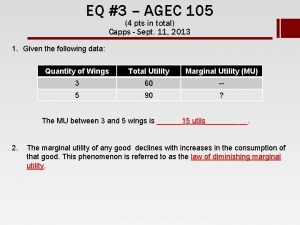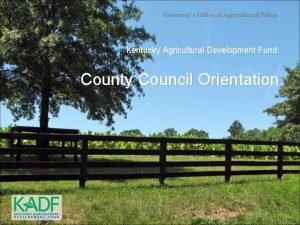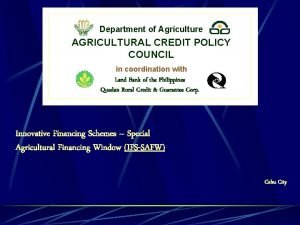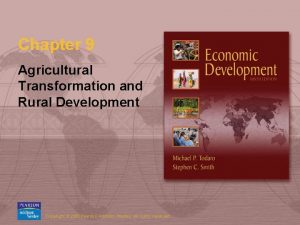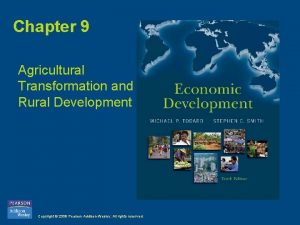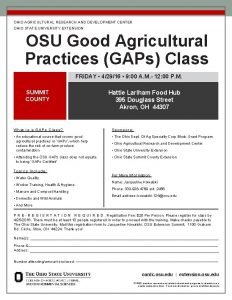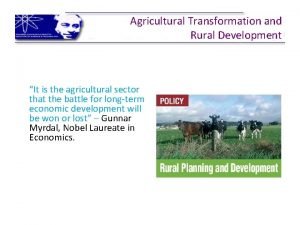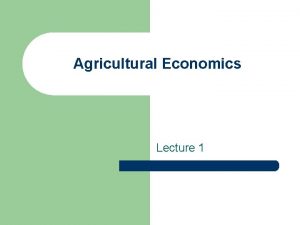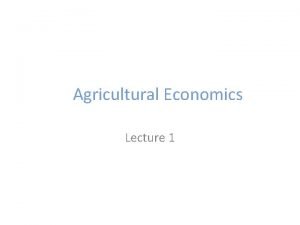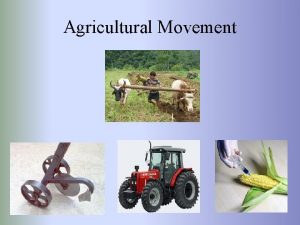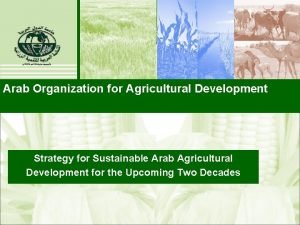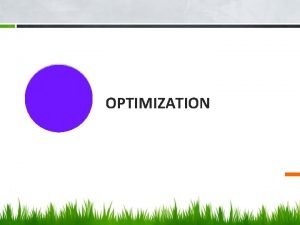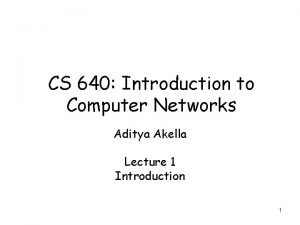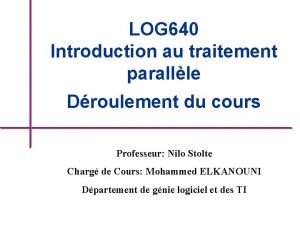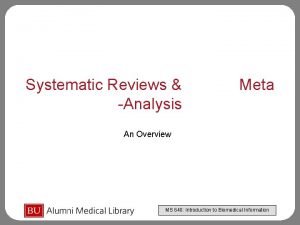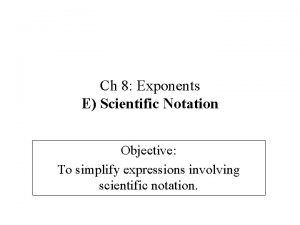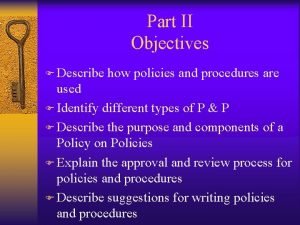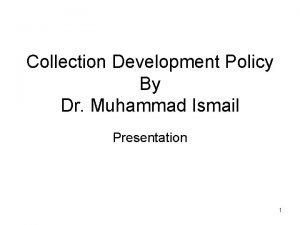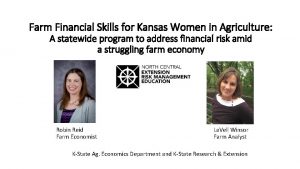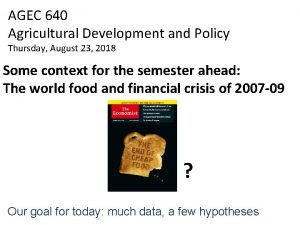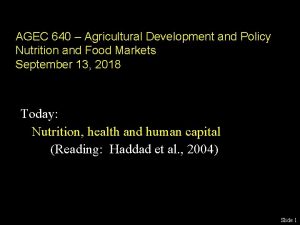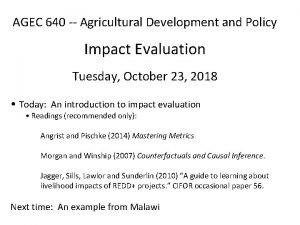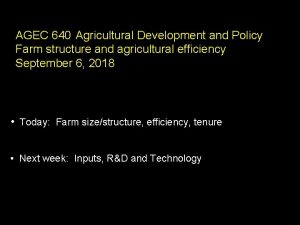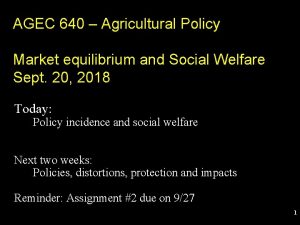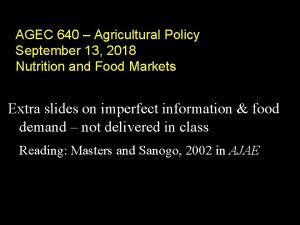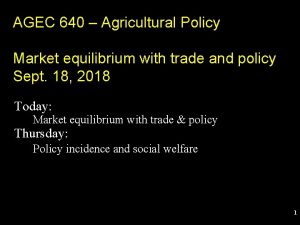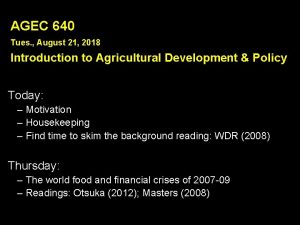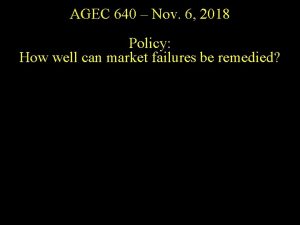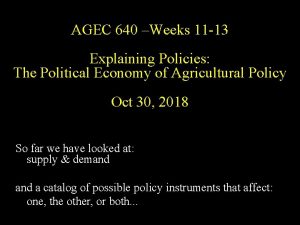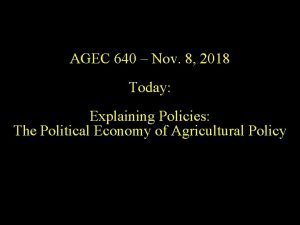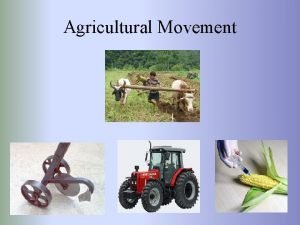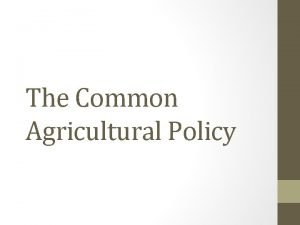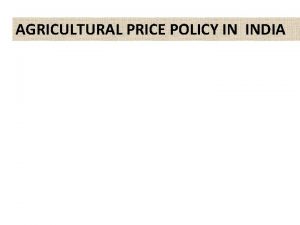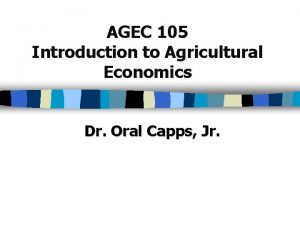AGEC 640 Agricultural Development and Policy August 28

































- Slides: 33

AGEC 640 Agricultural Development and Policy August 28, 2018 Today: – Farm problems and food problems – The “development paradox” – Structural transformation Thursday: – Population growth and the demographic transition

Readings for this week • Mc. Millan et al. “Globalization, Structural Change, and Productivity Growth, with an Update on Africa” World Development. • Norton, Alwang & Masters “Economic Transformation and Growth. ” Ch. 5 in Economics of Agricultural Development. • Tomich, Kilby and Johnston “Poverty and the Rural Economy” and “Structural Transformation” in Transforming Agrarian Economies. • Montgomery “Notes on the Demographic Transition. ”

Farm problems and food problems • First, some brainstorming: – What kinds of “problems” arise in agriculture? – What kinds of solutions do policymakers offer? (recall: USDA Release No. 0181. 16)

Where do we see what types of policies? Source: World Bank data, reprinted from UNEP/GRID-Arendal Maps and Graphics Library (http: //maps. grida. no/go/graphic/world-bank-country-income-groups).

This is the usual pattern: the “development paradox” Source: Peter Nicholson of “The Australian” newspaper (www. nicholsoncartoons. com. au)

When do we see what types of policies? Index of real international food prices, 1900 to 2005 (1977 -79 =100) Source: K. Anderson (2006), “Reducing Distortions to Agricultural Incentives: Progress, Pitfalls and Prospects. ” <www. worldbank. org/agdistortions>. Data shown are an index of export prices in US dollars for all major traded agricultural products, deflated by the MUV index which is the unit value of manufactures exported from France, Germany, Japan, UK and US, with weights based on those countries’ exports to developing countries.

The “development paradox” in East Asia, 1955 -2002 Average “Nominal Rate of Protection” for Agricultural Production in East Asia, 1955 -2002 Negative protection, i. e. taxation Source: K. Anderson (2006), “Reducing Distortions to Agricultural Incentives: Progress, Pitfalls and Prospects. ” <www. worldbank. org/agdistortions>

The “development paradox” for 68 countries, 1960 -2005 Effect of policy on farm product prices, by per-capita income level Above the line: support for agriculture ≈ $5, 000/yr Below the line: taxation of agriculture Note: Data shown are local polynomial regression lines and 95% confidence intervals through annual national-average Nominal Rate of Assistance (NRA) for 68 countries, covering more than 90% of world agriculture in each year from 1960 through 2005. Source: Masters & Garcia (2009) “Agricultural Price Distortion and Stabilization: Stylized Facts and Hypothesis Tests, ” in K. Anderson, ed. , Political Economy of Distortions to Agricultural Incentives. Washington, DC: The World Bank.

Why is this pattern paradoxical?

The development paradox: employment and earnings Source: Reprinted from World Bank, World Development Report 2008. Washington, DC: The World Bank (www. worldbank. org/wdr 2008)

Share of output from agriculture and mining in eight high-income countries, 1860 -1960 What happens next? Does the share fall to zero? Source: Reprinted from Tomich, Kilby & Johnston (1995) Transforming Agrarian Economies. Ithaca, NY: Cornell University Press.

The transformation is from agriculture to industry Share of output from industry in eight high-income countries, 1860 -1960 …but what happens next to industry’s share? Source: Reprinted from Tomich, Kilby & Johnston (1995) Transforming Agrarian Economies. Ithaca, NY: Cornell University Press.

…over the full span of development, employment shifts to services… Percent of workforce by sector in the United States, 1800 -2005 today, about 80% of US jobs are in services in 1800, employment was 90% farming in 1930 s-70 s, industry reached about 40% agricultural employment has stabilized Source: U. S. Economic Report of the President 2007 (www. gpoaccess. gov/eop)

As agriculture’s share of the economy declines, does farm income also fall? Agricultural Employment as a Share of Civilian Employment and Real Farm Output as a Share of Real GDP Until the 1930 s, employment and output fell together and then both stopped falling …then employment fell much faster than output SOURCE: U. S. Department of Commerce and the Federal Reserve Bank of St. Louis. Reprinted from K. L. Kliesen and W. Poole, 2000. "Agriculture Outcomes and Monetary Policy Actions: Kissin' Cousins? " Federal

What happens to labor? CARLs: Countries w/ Abundant Rural Labor Reprinted from Tomich, Kilby & Johnston (1995) Transforming Agrarian Economies. Ithaca, NY: Cornell University Press.

As agriculture’s share of the economy declines, what happens to farm income? Agricultural Employment as a Share of Civilian Employment and Real Farm Output as a Share of Real GDP Until the 1930 s, employment and output fell together and then both stopped falling …then employment fell much faster than output Reprinted from K. L. Kliesen and W. Poole, 2000. "Agriculture Outcomes and Monetary Policy Actions: Kissin‘

Another view of structural transformation India: ag labor productivity falling in relative terms Peru: ag labor productivity stagnant France: ag labor productivity increasing in relative terms Source: Figure 6 in Mc. Millan, M. et al. (2014) “Globalization, Structural Change, and Productivity Growth, with an Update on Africa. ” World Development 63: 11 -32

The US farm-nonfarm earnings gap, 1910 -2000 p n the Source: BL Gardner, 2000. “Economic Growth and Low Incomes in Agriculture. ” AJAE 82(5): 1059 -1074. Farm inco me f ell… ca tu h g u

Structural transformation: the story so far… (1) Farming declines as a fraction of the economy, as industry and services grow (2) Farmers’ incomes decline relative to other workers, but then catch up –in the U. S. , • farmers’ incomes began to catch up in 1933 • farmers’ incomes passed non-farmers in 1990 s (3) What happens within agriculture?

Does total world agricultural output decline? Source: Reprinted from FAO, State of Food and Agriculture 2007. Rome: FAO (www. fao. org)

The structural transformation in world trade: Agriculture’s share fell while its total value rose Source: Reprinted from FAO, State of Food and Agriculture 2007. Rome: FAO (www. fao. org)

Does U. S. agricultural output decline?

What happens to increases in U. S. output? ≈25 -30% exported ≈12 -25% exported Source: Farm receipts are from US Economic Report of the President 2007 (www. gpoaccess. gov/eop), Table B-97; exports are from USDA, Economic Research Service (www. ers. usda. gov/Data/FATUS). Both are converted to constant dollars using GDP deflator from Bureau of Economic Analysis (www. bea. gov).

Value-added exports grow the most! Source: USDA, Economic Research Service, Foreign Agricultural Trade of the United States (www. ers. usda. gov/Data/FATUS).

Within agriculture, the structural transformation brings specialization for inputs and marketing Source: Reprinted from World Bank, World Development Report 2008. Washington, DC: The World Bank (www. worldbank. org/wdr 2008)

The stylized facts of structural transformation (1) Farming declines as a fraction of the economy, as industry and services grow (2) Farmers’ incomes decline relative to other workers, but then catch up (3) Within agriculture, row-crop production fluctuates while agro-processing and agribusiness grows … but what drives this change? what explains it?

Explaining Structural Transformation Can consumers’ income growth explain the shift? – Engel’s law • As income grows, demand increases less for food and ag. products than for other things – The income-consumption curve for food is relatively flat – Income elasticity of demand for food < 1 – Bennett’s law • As income grows, demand increases least for basic staples and rises for higher value foods – The income-consumption curve for staples is very flat – Income elasticity of demand for staples ≈ 0 – Evidence for “increasing demand for variety”

Engel’s Law for (Global) Food Source: De Hoyos and Lessem (2008) “Food Shares in Consumption: New Evidence Using Engel Curves for the Developing World” https: //mywebspace. wisc. edu/rlessem/web/engel. pdf

Engel’s Law for food in Vietnam For the poorest group (Q 1), meat is a luxury; for the richest (Q 5) it is a normal good. For all income groups in Vietnam, rice appears to be a normal good. Source: Le, Canh Quang (2008) “An Empirical Study of Food Demand in Vietnam” ASEAN Economic Bulletin 25(3): 283 -292.

Explaining Structural Transformation Can new technology explain the shift? – New farm technology: “Cochrane’s Treadmill” • New farm technologies that increase output might lower prices and “push” farmers out • The demand curve for food is relatively steep – Food demand is price-inelastic: – Price elasticity for food < 1 in absolute value – Non-farm technology: bright lights, big city • New nonfarm technologies that create opportunities might “pull” farmers into nonfarm work – A “Harris-Todaro” world? • The demand curve for non-food is not as flat as for food – Non-food demand is price-elastic – Price elasticity for non-food >1 in abs. value

Engel’s Law for manufactured goods in Malaysia Source: Siddique, M. A. B. (1997) “Demand for machinery and manufactured goods in Malaysia” Mathematics and Computers in Simulation 43(3 -6): 481 -486.

Explaining Structural Transformation Limited land area may matter most of all: – Because total land area is fixed, • farmers’ savings and investment eventually runs out of uses on the farm, and is applied to other uses • farmers’ earnings are linked to the number of farmers, acres per farmer and earnings per acre – As # farmers grows… – Acres per farmer declines… – earnings per acre falls and earnings per farmer falls » Until what happens ? ? ?

Conclusions and the road ahead • Ag policies vary widely but show some regularities over time and across countries • A key regularity is the “development paradox”: – In poor countries, policies often try to reduce food prices – In richer countries, usually switch to raise farm incomes • This is closely linked to “structural transformation”, – from farm to non-farm employment and earnings – which in turn is closely linked to… • Thursday’s topic: the “demographic transition” – from high to low rates of deaths and births
 Dave padgett
Dave padgett Agec 105
Agec 105 Kentucky agricultural development fund
Kentucky agricultural development fund Credit safw
Credit safw Chapter 9 agricultural transformation and rural development
Chapter 9 agricultural transformation and rural development Chapter 9 agricultural transformation and rural development
Chapter 9 agricultural transformation and rural development Ohio agricultural research and development center
Ohio agricultural research and development center Agricultural transformation and rural development
Agricultural transformation and rural development What is agricultural development
What is agricultural development What is agricultural development
What is agricultural development The stages of agriculture
The stages of agriculture Arab organization for agricultural development
Arab organization for agricultural development Tmf 640
Tmf 640 Sybex ccna
Sybex ccna A deli sells 640 sandwiches
A deli sells 640 sandwiches Emc dd640
Emc dd640 Aditya akella
Aditya akella Heptarchy
Heptarchy Log 640
Log 640 Ccna voice 640-461 pdf
Ccna voice 640-461 pdf Gezang 123
Gezang 123 640 739 in expanded form
640 739 in expanded form 500 en yakın onluğa yuvarlama
500 en yakın onluğa yuvarlama Hino 640
Hino 640 Ms 640
Ms 640 Ccna 640-802
Ccna 640-802 640 000 in scientific notation
640 000 in scientific notation A 640 n hunter gets a rope
A 640 n hunter gets a rope 01:640:244 lecture notes - lecture 15: plat, idah, farad
01:640:244 lecture notes - lecture 15: plat, idah, farad January/february may/june
January/february may/june Policy development steps
Policy development steps Collection development policy
Collection development policy Agricultural accounting and finance kansas
Agricultural accounting and finance kansas Chapter 3 early humans and the agricultural revolution
Chapter 3 early humans and the agricultural revolution

